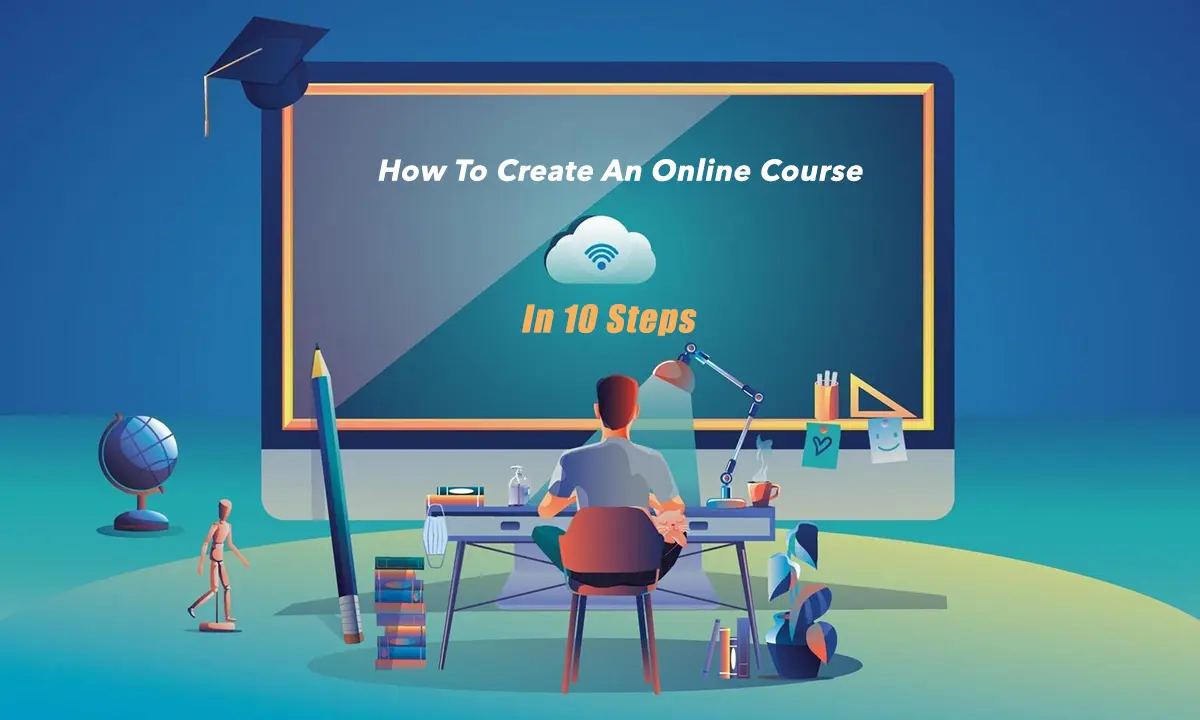How to Create an Online Course: A Step-by-Step Guide

The rise of online courses has revolutionized the way knowledge is shared, providing a dynamic platform for individuals to turn their expertise into a thriving business. Imagine channeling your passion and skills into a lucrative online course that not only enriches lives around the globe but also establishes you as a leading authority in your field.
In this comprehensive guide, we will walk you through the entire journey of creating an online course—from the initial spark of inspiration to the grand launch of your educational masterpiece. Whether you're an aspiring entrepreneur or a seasoned expert looking to expand your reach, this guide is designed to equip you with the essential tools and strategies to craft a compelling online course that makes a real impact and generates income.
What is an Online Course?
An online course is a structured learning program delivered entirely over the internet, designed to provide education and training in a variety of subjects without the need for physical attendance in a traditional classroom. This form of learning leverages digital platforms to offer multimedia content, interactive modules, and assessments, allowing for a dynamic and engaging educational experience.
Creators benefit from the flexibility to design and deliver their content in innovative ways, using videos, webinars, quizzes, and discussion forums to enhance the learning process. Learners, in turn, enjoy the convenience of accessing course materials at their own pace and from any location with an internet connection, making it easier to balance their studies with other commitments.
Benefits of Creating an Online Course
Creating an online course offers a multitude of advantages, including:
Financial Gain
Generate passive income by sharing your expertise and selling online courses to a global audience. Course sales can become a lucrative revenue stream as they help capitalize on the scalability of digital distribution, enabling creators to reach a wide range of learners without the limitations of physical location.
Whether you’re offering niche skill development, professional certification, or hobby-based learning, selling courses online allows you to tap into diverse markets and cater to various audience’s interests and needs.
Authority Building
Establish yourself as a thought leader in your field by sharing valuable knowledge and insights. By creating content for online learning platforms, you can showcase your expertise and provide learners with in-depth understanding and practical skills.
Incorporating knowledge checks throughout your courses helps reinforce learning and demonstrates your commitment to high educational standards. As you consistently deliver quality content and engage with your audience, you build credibility and trust, positioning yourself as a go-to resource and influencer within your niche.
Low Cost
Compared to traditional courses, online courses require minimal upfront investment, making them an accessible business opportunity for many aspiring educators and entrepreneurs. By leveraging digital tools and platforms, you can create and distribute a course for free or at a low cost, significantly reducing the financial barriers to entry.
In addition, selling courses online allows you to reach a broad audience without the expenses associated with physical classrooms, such as rent, materials, and travel. This cost-effective approach enables you to focus resources on enhancing course quality and marketing efforts, ultimately boosting course sales.
Global Reach
Teaching online allows you to break geographical barriers and share your knowledge with students worldwide, making education accessible to anyone with an internet connection. Through eLearning platforms, you can reach diverse audiences, transcending the limitations of physical classrooms and local boundaries.
This global reach not only broadens your impact but also enables you to connect with a variety of learners, fostering a richer educational experience. By leveraging digital tools and resources, you can create engaging and interactive courses that cater to different learning styles, ensuring that your content resonates with a wide range of students from different cultural and educational backgrounds.
How to Create an Online Course in 10 Steps

Here's a step-by-step breakdown to transform your expertise into a successful online course:
1. Choose Your Course Topic
When choosing your course topic, focus on three key elements: industry insight and credibility, passion, and market demand. First, select a topic where you possess in-depth knowledge and experience, such as digital marketing, programming, personal development, or graphic design, to establish your authority in the field and enhance your course creation process.
Your enthusiasm for the subject will translate into engaging content, motivating your students and enriching their online learning experience. Additionally, conduct thorough research to ensure your chosen topic aligns with current market interests and student needs, optimizing the potential for successfully selling online courses.
By balancing these factors, you can create a compelling and in-demand course that resonates with a global audience.
2. Do Some Customer Research to Validate Your Idea
To validate your course idea, start by conducting customer research to identify your target audience and understand their specific challenges and learning goals. Tailor your course content to address the pain points faced by your ideal students, ensuring your material is relevant and valuable.
Utilize tools like Google Trends to gauge search interest in your chosen topic, providing insights into market demand and helping you refine your course offering to better meet the needs of potential learners. By aligning your course creation efforts with the interests and needs of your target audience, you increase the likelihood of success in selling online courses.
3. Select Your Course’s Format
When deciding on the format for your course, think about both the amount of content you aim to provide and the learning preferences of your target audience. The way you organize and present your course will influence your marketing strategy, the extent of your curriculum, and the pricing you can set for your course.
Providing mini-courses is ideal for introducing core concepts in a concise, easily digestible format, making it perfect for busy learners or those new to the topic. If you want to extend your content more, multi-day courses offer more in-depth learning experiences, spread over several days or weeks, allowing students to absorb and apply knowledge incrementally.
For advanced learners seeking specialized instruction, a masterclass provides a focused, intensive learning experience, often led by a renowned expert in the field. This format is excellent for offering high-value, premium content that leverages the instructor's expertise and reputation.
4. Research to See If Your Course Has High Market Demand
Determine if your online course has high market demand by conducting thorough research and implementing strategic testing methods.
Start with creating a concise mini-course to introduce key concepts and gauge initial audience interest, allowing you to gather valuable feedback on content relevance and delivery. You can also consider hosting a free webinar focusing on a core topic from your course. This approach serves a dual purpose: it tests the market potential of your subject matter and helps you build an email list of interested participants.
Use tools like Google Trends to analyze search interest and identify trending topics in your field. Engage with potential learners through social media polls, online forums, and surveys to understand their specific needs and preferences. By combining these strategies, you can validate your course idea, refine your content, and ensure there is a strong market demand before fully committing to course creation and marketing efforts.
5. Outline and Structure Your Course Content
Break down your course material into logical modules and easily digestible lessons. This organization helps learners follow a clear, coherent progression through the course. Each module should cover a major topic, with individual lessons addressing specific subtopics within that area.
Determine the most suitable formats for your lessons to enhance engagement and cater to different learning styles. Incorporate a mix of video lectures, downloadable resources, quizzes, and interactive exercises to create a dynamic and interactive learning experience.
Video lectures can provide visual and auditory learning, downloadable resources offer additional reading and reference materials, quizzes reinforce knowledge retention, and interactive exercises promote active learning. By diversifying your lesson formats, you can keep learners engaged and facilitate a more comprehensive understanding of the course content.
6. Choose the Right Platform
Choosing the right platform for your online course is crucial to your success as a creator. There are numerous platforms available, each with unique features and pricing structures. Consider platforms like Fourthwall, Teachable, and LearnWorlds, which offer a range of tools to help you create and sell your courses effectively.
Fourthwall, for example, allows creators to seamlessly sell online courses directly from their homepage, making it easy to integrate with your existing website and brand. To set up your course on Fourthwall, start by adding product details such as the course name and an optional description. The description should provide potential learners with a clear understanding of what the course includes, setting the right expectations.
Next, upload the digital files that make up your course content. If there are multiple files, consider compressing them into a single zip file for easy download. Set a competitive selling price for your course and upload high-quality photos or graphics that represent your content. You can manage inventory settings, such as setting the stock to unlimited or specifying a limited quantity to create urgency.
Finally, make your course live by changing its status from hidden to public. By following these steps, you can effectively use Fourthwall to market and sell your online course, reaching a global audience and maximizing your potential for success.
7. Decide Pricing and Sales Goals
It’s important to evaluate the complexity and value of your course topic, as more specialized or advanced content can justify a higher price point. The authority of the course creator also plays a significant role; if you have established a strong reputation and are recognized as an expert in your field, you can command a premium price for your cours
Additionally, your marketing efforts should influence your pricing strategy. Effective marketing can increase your course's perceived value and reach your target audience more efficiently, allowing you to set higher prices. To establish realistic sales goals, assess the market demand for your topic and consider your overall business objectives, such as revenue targets and the number of students you aim to enroll.
8. Launch and Market Your Course
Once you’ve got your courses up and running it's time to consider how to best market them to your intended audience. Start by leveraging social media advertising to target your ideal student demographic.
Platforms like Facebook, Instagram, and LinkedIn offer sophisticated targeting options that allow you to reach potential learners based on their interests, behavior, and demographics. Complement these efforts with paid advertising strategies such as Google Ads, which can drive significant traffic to your course landing page by placing your ads in front of users searching for relevant keywords.
Additionally, implement robust Search Engine Optimization (SEO) tactics to improve your course's organic search ranking. This includes optimizing your course title, description, and content with relevant keywords, building backlinks, and ensuring your website is user-friendly and mobile-optimized. By combining these marketing strategies, you can maximize your course's visibility, attract a broader audience, and increase your enrollment numbers.
9. Collect Feedback and Testimonials
Encourage your customers to provide honest reviews and detailed feedback on their learning experience. Utilize surveys, email requests, and in-course prompts to gather their opinions on content quality, delivery, and overall satisfaction. Highlight positive testimonials on your course landing page, as they can significantly influence prospective students' decision to enroll.
Authentic reviews build trust and demonstrate the value of your course to potential buyers. Additionally, analyze the feedback to identify areas for improvement and implement changes to enhance the course's effectiveness and learner satisfaction.
This ongoing process of collecting and utilizing feedback helps you maintain high standards and stay responsive to your students' needs, ultimately leading to better course outcomes and higher enrollment rates.
10. Build a Community Around Your Content
Having an engaged online community transforms one-time customers into loyal, repeat customers who become brand advocates and mentors for new students. This community fosters direct relationships with learners, providing a platform for them to ask questions, share their experiences, and offer feedback.
This interaction helps you continuously improve your course content and delivery. Moreover, a vibrant community supports peer-to-peer learning, where students can collaborate, motivate each other, and share insights, thereby enriching the learning experience. As you observe your learners' progress, you can adapt your content to better meet their needs and ensure higher satisfaction rates.Additionally, an active community serves as a committed focus group, offering valuable insights into what works well and what can be improved, helping you refine your offerings and develop new courses.
Top 5 Mistakes to Avoid When Creating an Online Course
Creating an online course can be a rewarding experience, but avoiding common pitfalls is crucial for its success. Here are the top 5 mistakes to steer clear of:
- Not using clear learning objectives: Clearly define what students will learn by the end of your course. This will set expectations and ensure that your content is focused.
- Lack of interactivity and engagement: Don't let your course become a passive experience. Utilize quizzes, discussions, and assignments to keep students engaged.
- Poor-quality audio and video: Invest in decent audio and video equipment to ensure a professional presentation.
- Inadequate testing and feedback: Get feedback from potential students before launch and continuously refine your course based on student reviews.
- Ignoring accessibility and usability: Ensure your course is accessible for learners with disabilities by using captions, transcripts, and alternative content formats.
Frequently Asked Questions
Here are some answers to commonly asked questions about creating online courses:
What factors influence the profitability of creating an online course?
Course profitability hinges on various factors, including course topic, pricing strategy, marketing efforts, and platform fees. High-demand topics with effective marketing can lead to high profitability.
Can online courses be considered a reliable source of passive income, and if so, what ongoing efforts are required?
While online courses offer passive income potential, some ongoing efforts are crucial. This may include student support, course updates, and marketing to maintain a steady stream of students.
How much time investment is typically involved in creating an online course?
The time commitment varies depending on course complexity. Expect to invest time in content creation, recording, editing, and platform setup.
Start Selling Your Online Course with Fourthwall
Now that you're equipped with the knowledge to create a captivating online course, it's time to share it with the world! Fourthwall empowers you to seamlessly sell and manage your course with its user-friendly platform, allowing you to easily upload content, set pricing, and manage memberships.
Fourthwall simplifies video hosting for creators, enabling you to upload high-quality VOD content, categorize videos with tags, and build collections. The platform supports embedding video content from YouTube, Vimeo, and Streamable, ensuring top-notch playback on all devices. Additionally, Fourthwall provides detailed analytics to measure video performance and subscriber retention, helping you grow and engage your online community effectively.
So, if you’re ready to turn your expertise into a thriving online course, then explore Fourthwall today and start your journey to becoming a successful online educator!
















